
© 2010-2024 by Fine Arts of the Southwest, Inc. All rights reserved.
Unauthorized reproduction or use is strictly prohibited by law.
A rare early Hopi Silvercrafts Guild brass overlay-style cuff bracelet, c.1940’s
Ex: E. & E. Vanderwagen Trading Post, Vanderwagen, NM
This is unique one of-a-kind piece from the earliest days of The Hopi Silvercrafts Guild around 1946-47.
The Hopi Guild was tasked by the Hopi Tribal Authority with the task of developing a unique proprietary form of Hopi jewelry that was completely and uniquely Hopi in nature not a variation of already existing Native jewelry forms and techniques such as Navajo jewlery. Up until this time, the jewelry made by Hopi silversmiths was based upon the Navajo type of silversmithing.
The Hopi Tribal authority assigned this important effort to two of their most accomplished artists; painter, muralist and kachina carver, Fred Kabotie ()1900-1986) and jewelry-maker Paul Saufkie (1898-1993). They were assisted in this effort by the nearby Museum of Northern Arizona Flagstaff’s Co-founder and curator, Mary Russell Ferrell Colton and the Museum’s Fine Arts curator, Virgil Hubert.
This small group plus an initial class of students and apprentices, pictured below, began experimenting and eventually came up with the Hopi overlay style of jewelry which became the signature style of Hopi jewelry and continues on proudly to this day. The earliest experimentations were done using brass and copper which were much less expensive than silver and this bracelet is one of those prototype pieces. The overlay technique which involves one layer of metal being overlaid on top of another and then cut out, stamped and otherwise decorated with various designs so that the oxidized lowers layer shows through the openings in the upper layer to create contrast, texture and depth. This piece does precisely that. You can clearly see under a magnifying glass that
the bracelet’s shank is composed of two separate very thin layers of brass sandwiched together.
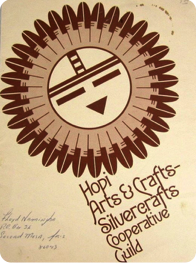
At upper left, an early Hopi Guild copper cuff bracelet with a cloud design, possibly by Paul Saufkie. At lower left, an original promotional pamphlet
for The Hopi Arts and Crafts Silvercrafts Cooperative Guild. At right, Hopi Silvercrafts Guild co-founders Fred Kabotie (left front) and Paul Saufkie
(right front) with their first group of GI Bill/Hopi Guild jewelry students c. 1947-49. Each of the students is holding a placard showing his personal hallmark. Paul Saufkie at lower right front row is holding his "Snow Cloud" hallmark which resembles the central design on the copper bracelet at upper left.
Lower left photo source and © Worthpoint. Right photo by Milton Snow. Photo source and © Nortthern Arizona University
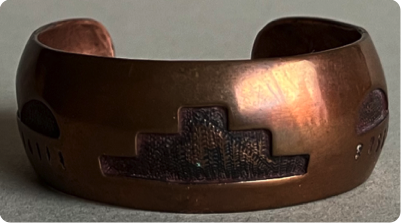
The evolution of Hopi overlay jewelry from its creation in the 1940’s to the 2000’s.
This beautiful Hopi triple-overlay silver bracelet by Michael Kabotie, Hopi Guild Co-Founder Fred Kabotie’s son shows how far
Hopi overlay jeweley has evolved in the decades since this early overlay brass bracelet was made and how much more complex and technically sophisticated it has become, but its conceptual brilliance as a uniquely Hopi jewelry idea remains completely relevant.
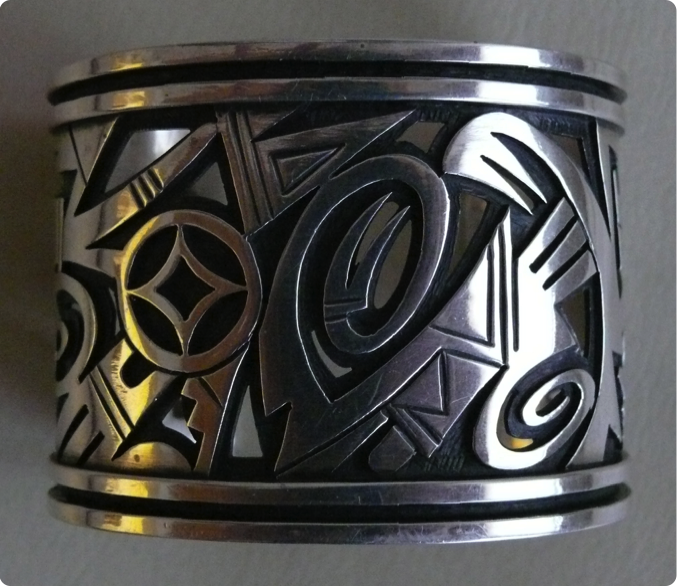
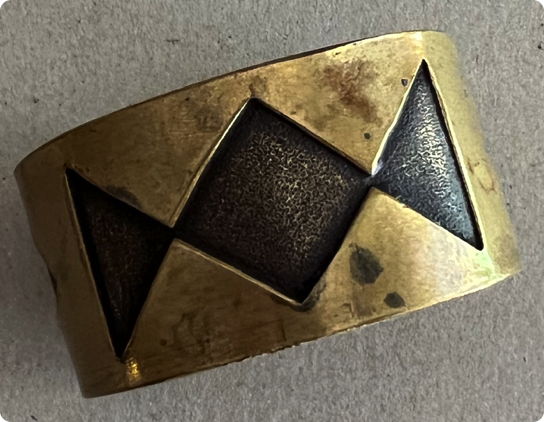

Although it is not nearly as technically refined and artistically complex as much of Hopi silver overlay jewelry would subsequently become, (SEE LAST PHOTO BELOW), this bracelet has a simple, unvarnished, beautiful and harmonious, uniquely Hopi design and the textures and oxidized dark nearly black underlay provides a beautiful visual contrast with the warm brass metal upper layer which has acquired a beautiful rich patina over the past nearly 80 years since it was created. The design is beautifully simple yet decidedly Modernistic and somewhat
stark in its presentation, a series of repeating diamonds and triangles or terraces which intersect nicely to form stylized butterfly shapes. These designs are uniquely Hopi and are also found elsewhere in Hopi material culture, on weddings mantas or dresses, pottery and kachina headdresses.
This bracelet is a real Native American art connoisseur’s or historian’s piece and the next mystery is who might have made it. It was clearly made before the Hopi Guild settled upon their signature hallmark which is a stamped Hopi “Dawa” or Sun Face design as seen above which all later official Hopi Silvercrafts Guild jewelry pieces were marked with this hallmark along with occasionally the initials or insignias of the individual artists. This bracelet is marked only with the somewhat crudely inscribed initials "QT" and a partial Hopi clouds and rain symbol. Due to its not very well-executed nature, this does not appear to us to be an artist's signature, but rather an inscription by a previous owner or possibly even a scratched-in Indian trader's code which was a very common occurence.
The bracelet measures 1 3/16" in continuous width all the way around. The inner circumference end-to-end is 5 1/4" and the gap between the terminals is 15/16" for a total interior circumference of 6 3/16". The bracelet’s brass shank is 1/16" in thickness. The bracelet weighs a comfortable and easy to wear 54 grams or 1 7/8 ounces.
The bracelet is in good original vintage condition with some age-appropriate staining and tarnishing. This could
be removed if desired with brass polishing compound, but we prefer to keep it in its original, well-patinated state
as it shows its history and the interesting long life it has led.
The bracelet’s provenance is as interesting and historic as the piece itself, its previous owner from whom we acquired it purchased it some fifty-plus years ago in the early 1970’s from Ernie and Esther Vanderwagen’s famous Vanderwagen trading post in Vanderwagen, NM just a few miles north of the Zuni Pueblo. The Vanderwagen family had owned and operated trading posts in and around Zuni since around 1900. This area is also home to Ramah Navajo Reservation, a smaller offshoot of the greater Navajo Reservation.
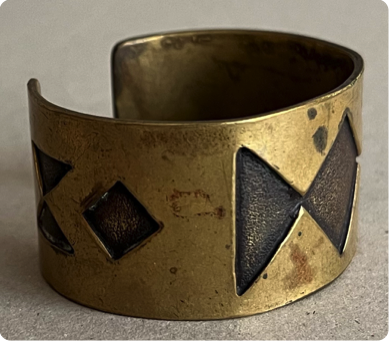
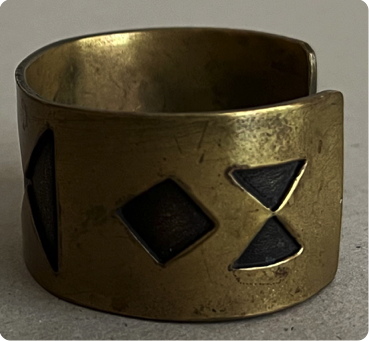
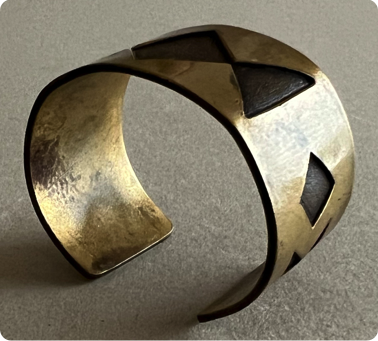
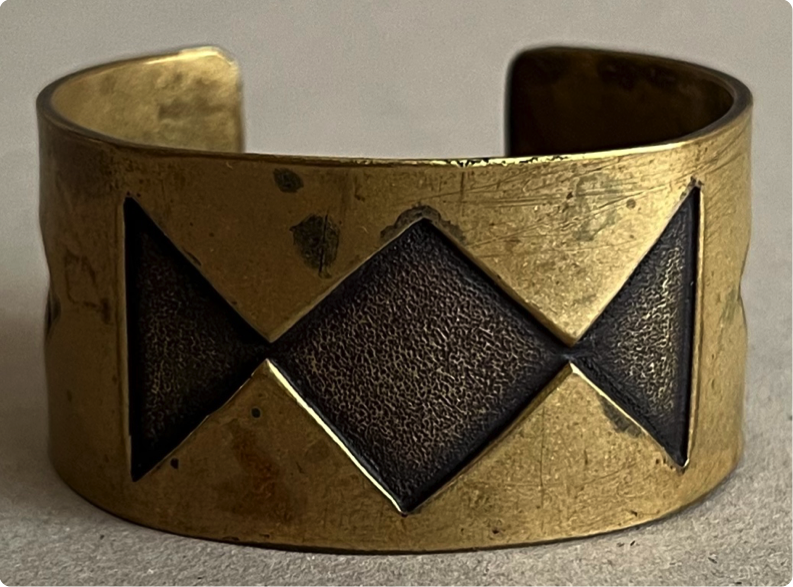

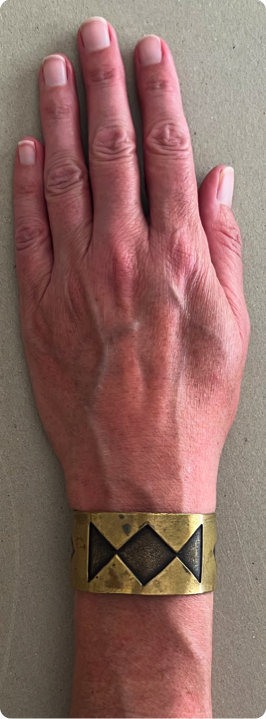


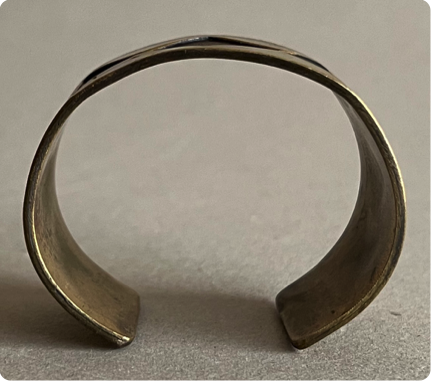
Vanderwagen’s was one of the most prominent and finest trading posts of its era (1900’S-90’S) and a great many extraordinary pieces of Navajo and Zuni jewelery, Pueblo pottery and weavings, a large number of which are now in museums and important private collections today passed through its doors and over its counters. During this time period, there was much travel and personal interchange between Zuni Pueblo and the Hopi villages to the west. Important Hopi artists such as Daisy Hooee Nampeyo and Nellie Douma Nampeyo were married to Zuni men and lived at Zuni for extended time periods and it is entirely possible that this bracelet came to the Zuni area Vanderwagen Trading Post from one of them or one of their relatives.
However it found its way to a prestigious trading post near Zuni Pueblo, this bracelet is a unique and deeply historic Hopi jewelry piece, a piece it would be a pleasure and a privilege to own and enjoy for its special beauty, pioneering craftsmanship and considerable historic significance.
Price $975